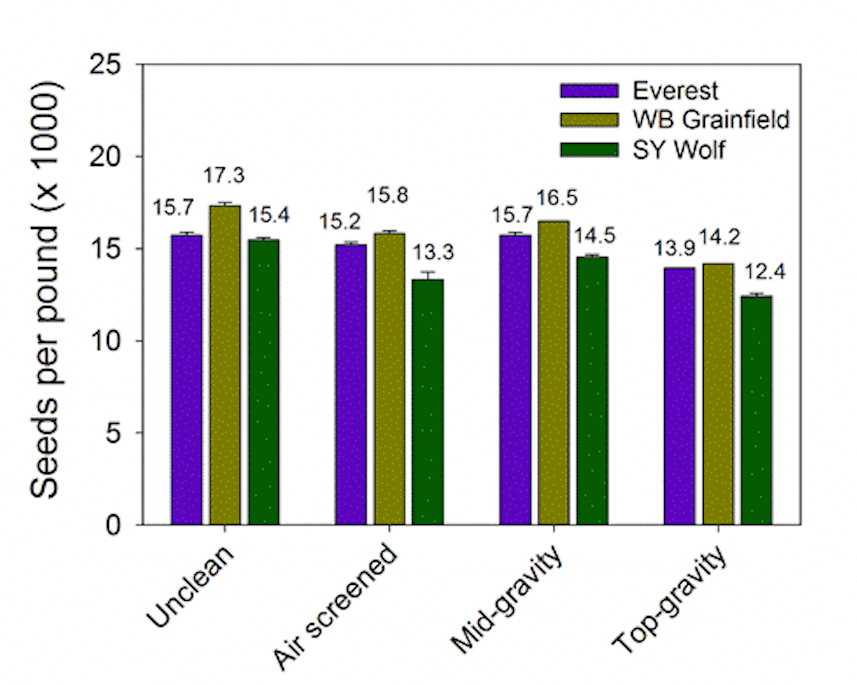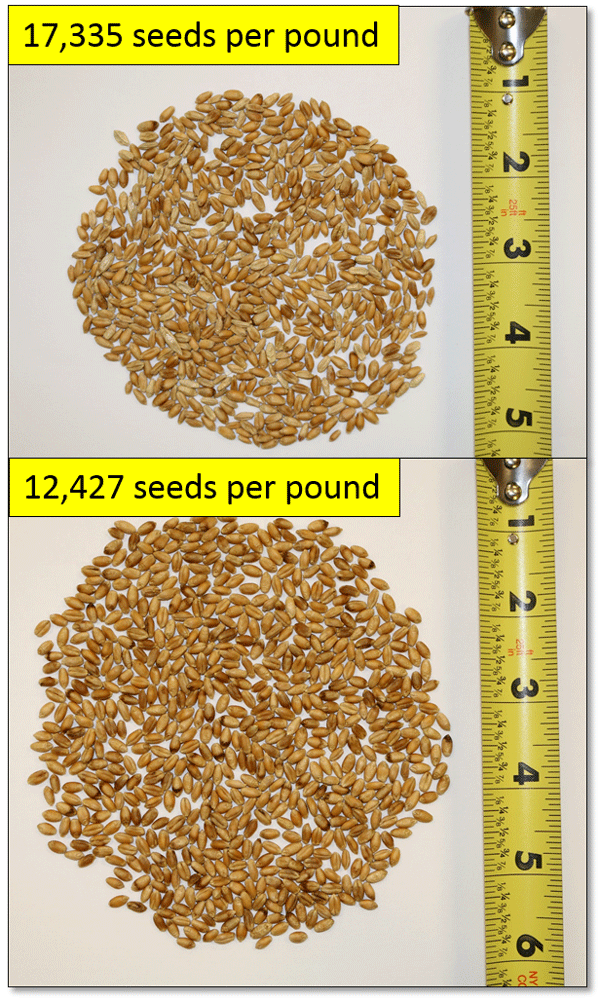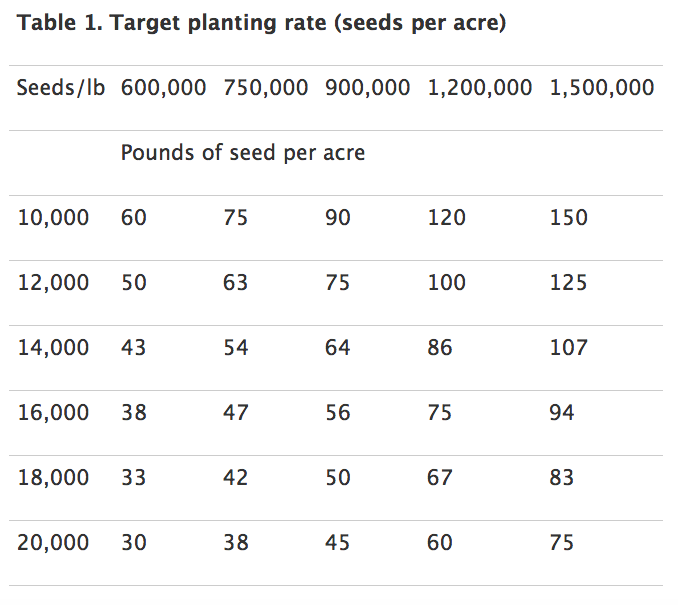By Romulo Lollato, Wheat and Forages Specialist; Lucas Haag, Northwest Area Crops and Soils Specialist
Wheat seeding rate recommendations in Kansas are often stated in terms of pounds of seed per acre, and vary according to precipitation zone. However, seed size can have an impact in the final number of seeds actually planted per acre.
A variety with larger kernels, when planted according to pounds per acre recommendations, will result in fewer seeds planted per acre and thinner stands than a variety with smaller kernels. As a result, if the weather and fertility during the growing season are not favorable for tiller formation and survival, grain yields may be reduced due to the resultant thinner stand.
Another advantage of planting in terms of seeds per acre rather than pounds per acre is that seed costs can be reduced for varieties with a small kernel size when wheat kernel size.
Seed size can be measured in terms of the number of seeds per pound. The “normal” range is about 14,000-16,000 seeds per pound, but it can range from 10,000 seeds per pound to more than 18,000 seeds per pound.
Although seed size is specific to each individual wheat variety, it can vary within variety depending on seed lot and seed cleaning process. Figure 1 shows three different wheat varieties and, for each variety, seed size as affected by seed cleaning method. For this simple study, the varieties Everest, WB-Grainfield, and SY Wolf were evaluated at different times during the seed cleaning process: “Unclean” (harvested seed before cleaning), “Air screened” (seed following air cleaning or the blower), “Mid gravity” (seed from the low end of the gravity table), and “Top gravity” (the seed from the top end of the gravity table).
It is clear from Figure 1 that wheat variety plays a major role in determining wheat kernel size, as does the quality of seed cleaning. Overall, the number of seeds per pound decreased (or individual seed size increased) as the quality of the seed cleaning process increased.
 Figure 1
Figure 1
The two most contrasting treatments from the above study, the “Unclean” WB-Grainfield (top figure, 17,335 seeds per pound) vs. the “Top-gravity” SY Wolf (bottom figure, 12,427 seeds per pound) are shown in Figure 2. To achieve the same number of seeds per acre at seeding, “Top-gravity” SY Wolf would require a 39% increase in pounds per acre planted when compared to “Unclean” WB-Grainfield.
In other words, if both varieties are planted at a seeding rate of 75 pounds per acre, the final number of seeds planted per acre will be 1.3 million seeds per acre for “Unclean” WB-Grainfield and 930,000 seeds per acre for “Top-gravity” SY Wolf.
 Figure 2
Figure 2
If the goal was to achieve 1.2 million planted seeds per acre, wheat would be over-seeded at about 8% for the smaller seed and under-seeded in about 22.5% for the larger seed when using a seeding rate of 75 pounds per acre for both. This assumes the same emergence rate for the cleaned and uncleaned seed, which would not necessarily be expected.
These results highlight the importance of measuring wheat seed size before planting to ensure the final amount of seeds planted per acre will be close to the original target.
Certified seed, or seed submitted for germination testing, will have seeds-per-pound information available. However, an easy on-farm method to estimate the average seed weight of a seed lot is to collect several representative 100-seed samples and weigh each 100-seed sample in grams.
To calculate seeds per pound, divide the conversion factor 45,360 by the average weight of the 100-seed samples. Samples should be collected from the lot as is, including large and small kernels in the same proportion as found in the seed lot. The targeted number of seeds per acre is then divided by the number of seeds per pound to determine the number of pounds to be planted per acre. The following table is a quick reference guide to adjust the planting rate in pounds per acre based on seed size and the targeted number of seeds planted per acre.

How to Use Table 1
A dryland wheat producer in western Kansas whose target seeding rate may be 750,000 seeds per acre has a seed lot with large kernels, averaging 12,000 seeds per pound. The seeding rate in pounds per acre for this seed lot for a final placement of 750,000 seeds per acre should be about 63 pounds per acre. The same producer planting a different lot with smaller seeds averaging 16,000 seeds per pound should plant about 47 pounds per acre to achieve the same final seed placement of 750,000 seeds per acre.
A wheat producer in eastern Kansas whose target may be 1.2 million seeds per acre has two seed lots; the first averaging 14,000 seeds per pound and the second, with slightly smaller kernels, averaging 16,000 seeds per pound. This producer should use a seeding rate of 86 pounds per acre in the first seed lot and 75 pounds per acre in the second seed lot to achieve the same final seed placement (in terms of number of seeds per acre).
In this case, both seed lots were in the “normal” range of about 14,000-16,000 seeds per pound, and a simple ±10% adjustment on the seeding rate should compensate for differences in seed size.





